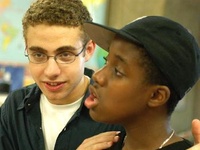But the program isn’t only focused on secondary education. Summerbridge also strives to put its students on the path to college, she says—beginning with their application to the program.
Each year, representatives from the Summerbridge program visit every fifth-grade classroom in Cambridge to extend invitations to the program. This past year, 14 percent of Cambridge middle schoolers completed the application process, which included a written component and an interview.
For the 10 percent of Cambridge students admitted to the program, Mead says, applying becomes “a piece of cultural capital,” building their confidence for similar applications to high school or college.
But for those who want to teach with the program, the application process is more competitive still.
This year, 397 teachers applied for 42 available spots in Cambridge, Mead says.
Both peers and professional educators observe a student teacher’s class each week and offer constructive evaluations. At the end of the summer, the student teachers prepare special portfolios and write “philosophy of education” statements.
The teachers say this constant feedback—combined with the daunting prospect of facing a classroom full of students every morning—makes Summerbridge an experience with an acute learning curve.
Josh Billings ’07—who planned to spend the summer in Tibet—says his experience so far has been an engaging substitute for global travel.
“I don’t know if I could be learning more if I were on a mountain halfway around the world,” he says.
Mission: Possible
As the breakfast period ends, the “Mission: Impossible” theme suddenly rattles from a boombox and two teachers race across the cafeteria in tight black clothing and sinister sunglasses.
A “Mission: Impossible” theme will be reiterated throughout the week, explains literature teacher Claire A. Pasternack ’05, who is also a Crimson editor.
Summerbridge students take four classes each morning, but the order of the courses varies through the week. A mid-morning snack affords student and their teachers a break from the classroom and an opportunity to meet in their “clusters”—teams of about 20 students that are the basis for some of the program’s activities.
Toward the end of the morning, Billings teaches a mathematics class.
He asks a few of his students to diagram bacteria replication on the blackboard. “What do we call that?” he asks
Read more in News
College Dems Rally For Kerry














